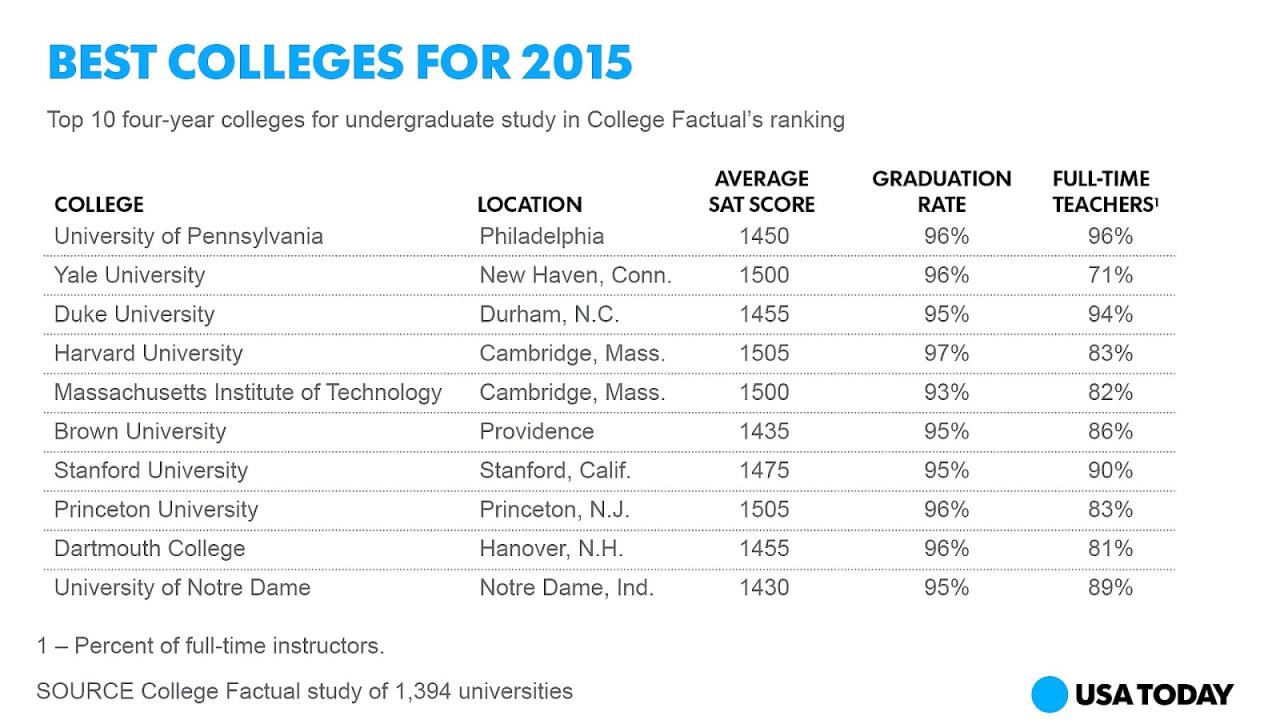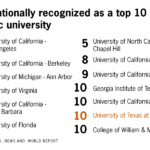US Colleges and Universities Rankings are a significant factor influencing student choices and institutional strategies. This guide delves into the intricacies of various ranking methodologies, exploring their strengths, weaknesses, and impact on the higher education landscape. We will examine how rankings influence application patterns, marketing approaches, and the financial realities of college selection. Furthermore, we’ll consider regional disparities, the public versus private institution divide, and the evolving role of alumni networks and specialized subject rankings.
Understanding these rankings requires a critical eye. We will analyze the biases inherent in these systems, discussing potential manipulations and ultimately, how these limitations affect the crucial decision-making process for prospective students. The discussion will also incorporate the perspectives of international students, highlighting their unique considerations when navigating the complex world of US higher education rankings.
Ranking Methodology Variations

The landscape of US college and university rankings is complex, with various organizations employing different methodologies to assess and compare institutions. Understanding these variations is crucial for interpreting rankings effectively, as different weighting schemes prioritize diverse aspects of higher education. This analysis compares the approaches of three prominent ranking systems: US News & World Report, Times Higher Education (THE), and the Wall Street Journal/Times Higher Education (WSJ/THE) collaboration.
Each ranking system utilizes a proprietary algorithm, combining various indicators to generate an overall score. However, the relative importance assigned to each factor differs significantly, leading to variations in the resulting rankings. For instance, while all three systems consider factors like academic reputation and student selectivity, their weighting and data sources vary considerably. This often results in different institutions achieving higher rankings in one system compared to others.
Weighting of Factors in Major Ranking Systems
The weighting of factors across the three ranking systems reveals distinct priorities. US News & World Report places significant emphasis on peer assessment scores from academics and high school counselors, giving considerable weight to reputational factors. They also heavily consider student selectivity, measured by acceptance rates and standardized test scores. Research output, while included, receives less weight compared to other factors.
In contrast, Times Higher Education (THE) incorporates a broader range of indicators, giving significant weight to research output, measured by citations per faculty and research income. They also consider teaching resources, including student-to-faculty ratio and the proportion of doctorate-holding faculty. Student selectivity plays a smaller role compared to US News & World Report. The WSJ/THE collaboration, a joint venture, blends aspects of both methodologies, aiming for a balance between research excellence and student experience.
A Hypothetical Ranking System Prioritizing Factors Beyond Academic Reputation
A hypothetical ranking system designed to prioritize factors beyond academic reputation might focus on factors such as student outcomes, affordability, and social mobility. This system could utilize metrics such as graduate employment rates, average starting salaries, student loan default rates, and the proportion of students from low-income backgrounds who successfully graduate.
Such a system could assign a significant weight to the percentage of graduates securing employment within a year of graduation, incorporating data on starting salaries and career progression. Affordability could be assessed by considering tuition costs, financial aid availability, and the average student debt upon graduation. Finally, social mobility could be measured by tracking the socioeconomic background of students and their subsequent educational and professional achievements, demonstrating the institution’s effectiveness in promoting upward mobility.
This approach would shift the focus from solely prioritizing prestige and selectivity to a more holistic evaluation that considers the broader societal impact of higher education. It could offer a valuable alternative perspective, highlighting institutions that excel in providing accessible, affordable, and impactful education, regardless of their established reputation.
Regional Variations in Rankings: Us Colleges And Universities Rankings

College rankings, while offering a general overview of academic excellence, often fail to fully capture the nuanced differences between institutions across various regions of the United States. Regional factors, including economic conditions, student demographics, and institutional priorities, significantly influence a college’s strengths and ultimately, its ranking performance. Understanding these regional variations provides a more complete picture of the higher education landscape.
Analyzing the ranking positions of prominent colleges across different regions reveals interesting patterns. For instance, the Northeast consistently features a high concentration of Ivy League and other highly selective institutions, often emphasizing research and a strong liberal arts tradition. The West Coast, on the other hand, tends to showcase a blend of prestigious private universities and strong public systems, with a notable focus on technology and innovation. Southern institutions, meanwhile, often exhibit a diversity of strengths, ranging from strong liberal arts programs to burgeoning research universities, often with a more pronounced emphasis on specific fields like business or engineering.
Top-Ranked Colleges by Region, Us colleges and universities rankings
The following table presents a snapshot of top-ranked colleges by region, illustrating the diversity of excellence across the US. It’s important to note that rankings vary depending on the methodology used, and this table represents a composite view based on several widely respected ranking systems. Further, the selection of colleges is not exhaustive, but rather representative of the leading institutions within each region.
| Region | College Name | Notable Characteristics | Representative Ranking (Illustrative) |
|---|---|---|---|
| Northeast | Harvard University | Extensive research, strong liberal arts, highly selective admissions | Top 5 consistently |
| Northeast | Massachusetts Institute of Technology (MIT) | World-renowned STEM programs, intense focus on technology and innovation | Top 5 consistently |
| West Coast | Stanford University | Strong emphasis on entrepreneurship, cutting-edge research, highly selective | Top 5 consistently |
| West Coast | California Institute of Technology (Caltech) | World-class science and engineering programs, highly selective and research-focused | Top 10 consistently |
| South | Duke University | Strong liberal arts foundation, renowned medical school, highly selective | Top 10 consistently |
| South | University of Texas at Austin | Large public university, strong business and engineering programs | Top 50 consistently |
| Midwest | University of Chicago | Rigorous academics, strong emphasis on research, particularly in the humanities and social sciences | Top 10 consistently |
| Midwest | University of Michigan-Ann Arbor | Large public university with a wide range of strong programs, extensive research opportunities | Top 30 consistently |
Navigating the world of US college and university rankings requires a nuanced understanding of their methodologies, limitations, and impact. While rankings offer a valuable snapshot of institutional performance, they shouldn’t be the sole determinant in the college selection process. A holistic approach, considering individual student needs, academic goals, and financial realities, alongside a critical evaluation of ranking systems, ultimately leads to a more informed and successful higher education journey. This guide serves as a starting point for that critical evaluation, prompting a deeper exploration of the factors that truly define a quality educational experience.
US college and university rankings are frequently consulted by prospective students, offering a snapshot of institutional prestige and academic strength. A prominent institution often featured in these rankings is Clemson University, whose standing you can explore in detail via this helpful resource: clemson university ranking. Ultimately, these rankings provide a valuable, albeit incomplete, picture within the broader landscape of US higher education.
US college and university rankings are frequently consulted by prospective students, offering a snapshot of institutional strengths. A prominent example within these rankings is the University of Colorado Boulder, whose standing you can explore further by checking out its ranking on this site: university of colorado boulder ranking. Ultimately, these rankings provide a valuable, though not exhaustive, perspective when considering higher education options.


